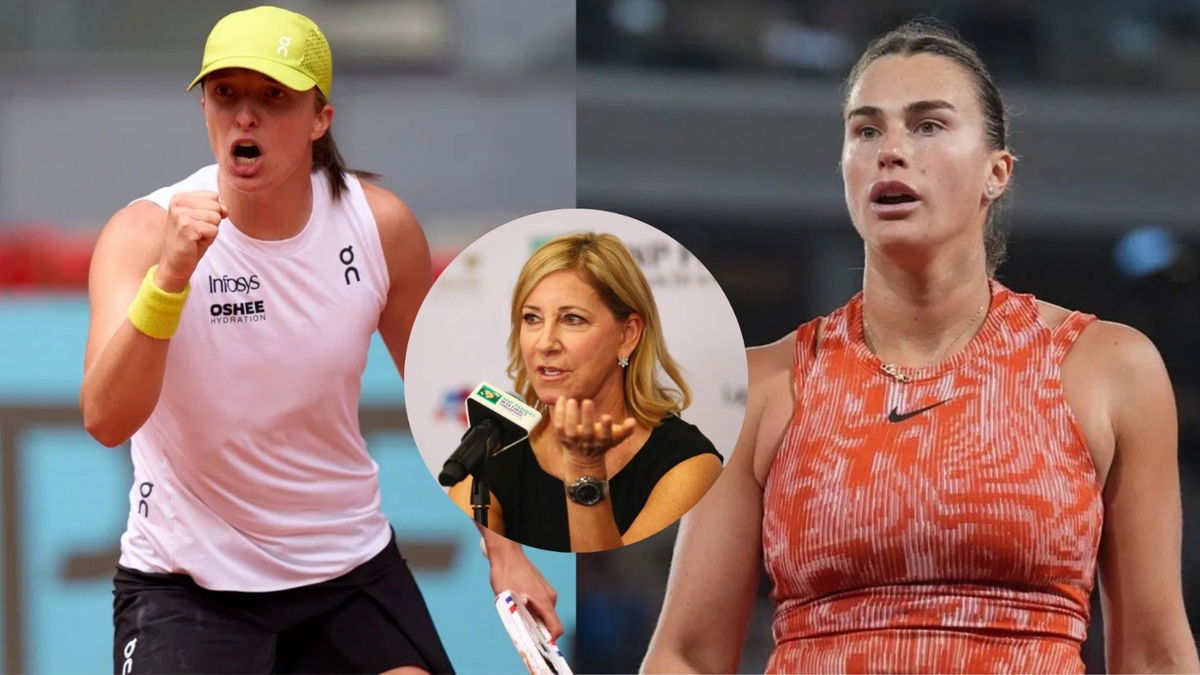
Imago
(Credits: Imago and Getty Images)

Imago
(Credits: Imago and Getty Images)
When the French Open draw came out two weeks ago, there was one matchup that had everyone buzzing. Iga Swiatek, the reigning Roland Garros queen and world No.1 Aryna Sabalenka were on a collision course for the semi-finals. The duo has ruled the WTA Tour for the past three years, and their budding rivalry is quickly becoming the stuff of tennis legend. Now, with both players storming into the final four, the much-anticipated showdown finally arrived on Thursday. And let’s just say, it didn’t take long for the drama to kick in.
Watch What’s Trending Now!
Aryna Sabalenka came out firing. She broke Iga Swiatek twice and looked ready to run away with the set. At 4-1 up, the Belarusian was serving to go 5-1 when a moment of confusion turned the tide. Sabalenka hit what looked like a clean ace down the middle. She celebrated. The crowd clapped. And then came the voice of chair umpire Kader Nouni—”let, second serve.”
Both players froze. The World No.1 walked to the chair in disbelief while Iga Swiatek stood across the net, looking just as confused. The top seed had to go back to the service line and try again. But the rhythm was gone. The Pole pounced on the next point and broke serve. From there, momentum flipped. Aryna Sabalenka’s stronghold collapsed, and soon the scoreboard read 6-6. She eventually turned it around in the tiebreak and won the first set.
ADVERTISEMENT
But here’s the kicker: Hawk-Eye later showed the so-called let serve was actually clean. The ace was in. Tennis legend Chris Evert, commentating on the French Open, couldn’t help but chime in with a quip: “Can’t wait for next year, electronic line calls.”
Another questionable line call gives Swiatek the break.
(HE says out, umpire says in)
Evert: "can't wait for next year, electronic line calls"
I thought RG would be forced to implement it starting this year. Too bad they didn't.— C Kristjánsdóttir ●🐊 (@CristinaNcl) June 5, 2025
Serena Williams’ ex-coach Rennae Stubbs had echoed a similar sentiment during Mirra Andreeva’s match against Lois Boisson. At 3-3 in the second set, with the Russian serving and down 0-30, things took a tense turn. Lois Boisson challenged a line call, claiming the ball was in. The umpire stepped down to check the mark on the clay and confirmed Boisson’s challenge was successful.
ADVERTISEMENT
But Andreeva wasn’t having it. The 18-year-old argued that the clay had been moved by the ball, insisting it was out. She gestured at the mark and pleaded her case, but the umpire stood firm. From there, the momentum shifted. Andreeva never quite regained her composure, and Boisson capitalized. The French wildcard held her nerve and rolled through the rest of the match, sealing a straight-sets victory and punching her ticket to her first-ever Grand Slam semifinal.
After the match, Stubbs took to X and wrote, “3-3 0-30 Andreeva got screwed. U clearly see the ball push the clay off the line. Mirra actually said to the umpire, “the clay went off the line” & she was right, there was another ball mark there & that’s the one the used to say out. WHEN ARE WE GETTING ELECTRONIC LINE CALLING!”
ADVERTISEMENT
So why does the French Open not use Hawk-Eye?
Swiatek-Sabalenka clash exposes French Open’s Hawkeye problem
Roland Garros remains the last Grand Slam standing when it comes to using line judges. Unlike the other majors, players in Paris can’t challenge calls using electronic review systems. The official reason being the clay. It’s been said that the red dust, which shifts during play, makes it tough for electronic line calling (ELC) systems to work accurately. The surface is “live,” constantly changing, and that supposedly interferes with the tech.
ADVERTISEMENT
But according to Paul Hawkins, the man behind Hawk-Eye, that’s not the full story. He claims the technology works just fine on clay. According to him, it’s actually the mark left by the ball that isn’t reliable. That small impression in the clay, often treated like gospel, isn’t always what it seems. Meanwhile, the other Grand Slams have moved on. The Australian Open and US Open ditched line judges altogether, first Melbourne in 2021, then New York in 2022. Wimbledon, which introduced Hawk-Eye way back in 2007 to confirm line calls, is finally making the full switch this year. After 147 years of human line calling, it’s going all-in on the electronic system.
That said, the transition hasn’t been totally smooth elsewhere on clay. Some tournaments that installed ELC faced teething issues. There have been plenty of moments when tech and eyeballs didn’t agree. One example came in Madrid, where Alexander Zverev took a photo of what he insisted was an out ball from Alejandro Davidovich Fokina, only for the ELC to call it in.
Even Aryna Sabalenka is struggling to make up her mind. “Honestly, I’m so confused, I don’t know (which I prefer),” Sabalenka admitted. She was at the center of a weird moment last month in Stuttgart, where there was no electronic line calling. She took a picture of a ball mark with her phone to argue a call—and got hit with a code violation. “I had situation with the referee in Stuttgart, and also there was tricky calls with the Hawk-Eye system in Rome. So I’m really confused what I prefer, to be honest.”
ADVERTISEMENT
As tennis shifts toward full automation, Roland Garros remains the lone holdout, clinging to tradition. But with confusion mounting, is it finally time for clay to go digital? Let us know your thoughts below!
ADVERTISEMENT
ADVERTISEMENT
ADVERTISEMENT

